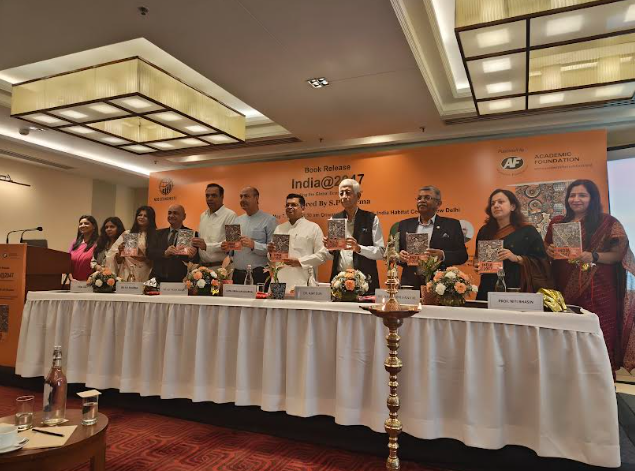
At the India Habitat Centre in New Delhi, the launch of Dr. S.P. Sharma’s book, India@2047: Leading the Global Economic Order, was marked by optimism, realism, and a roadmap for India’s journey toward becoming a global economic superpower.
Several distinguished dignitaries graced the occasion. The Chief Guest was Shri Gopal Krishna Agarwal, National Spokesperson of the Bharatiya Janata Party (BJP). The Guests of Honour included Prof. R.M. Joshi, Vice Chancellor of the Indian Institute of Foreign Trade; Dr. Ajay Dua (IAF Retd.), former Secretary, Ministry of Commerce and Industry; Shri Saurabh Sanyal, former Secretary General of PHD Chamber, Prof. Niti Bhasin from the Department of Commerce, Delhi School of Economics; and Shri A.P. Vicky Shaw from the Jammu and Kashmir Chapter of the PHD Chamber. The event was eloquently anchored by Ms. Teena Jha, Senior Anchor at Sansad TV.
Dr. Sharma, Chief Economist at Neo Economists addressed a distinguished audience comprising business leaders, scholars, and policymakers, offering deep insights into India’s economic trajectory and the future he envisions for a “Viksit Bharat” by 2047.
A Nation at an Inflection Point
Opening his address, Dr. Sharma reflected on India’s economic transformation over the decades. “India is at the cusp of transformation. The journey of economic reforms, digital revolution, and global partnerships has brought us to an inflection point—one that demands both introspection and ambition,” he remarked.
He highlighted how consistent reforms since the 1991 liberalization era, further accelerated by structural initiatives under the leadership of Prime Minister Narendra Modi, have put India on a path of sustained growth.
From Resilience to Leadership
India, now the world’s fifth-largest economy with a GDP exceeding USD 3.7 trillion, is poised to become the third-largest economy by 2030 and potentially reach USD 35 trillion by 2047, according to projections laid out in Dr. Sharma’s book. He added, “With a strong demographic dividend, rising innovation capabilities, and a thriving entrepreneurial ecosystem, India’s rise is inevitable if guided by sound policy and global cooperation.”
Quoting from the book, he stated, “India@2047 is not merely a timeline—it is a national mission. It envisions an India that is developed, equitable, sustainable, and globally respected.”
Strategic Trade Partnerships
He pointed to India’s dynamic and evolving foreign trade architecture. Citing the recently concluded Free Trade Agreement with the United Kingdom, he said, “This agreement is more than just a trade pact—it reflects deeper economic synergy and the transformation of our historical ties into modern-day partnerships.”
India’s total exports of goods and services now exceed USD 770 billion, making it one of the fastest-growing exporting nations globally. Dr. Sharma credited strong bilateral and multilateral engagement for this rise: “Trade agreements, whether with the UK, Australia, UAE, or under initiatives like IPEF and Indo-Pacific engagements, are shaping India’s strategic economic footprint.”
The Modi Factor and Global Confidence
Throughout his address, Dr. Sharma emphasised the importance of political leadership in building economic momentum. “The long-pending agreement with the UK finally materialised due to the strong diplomatic and economic leadership of our Hon’ble Prime Minister,” he stated.
He underscored that India’s ability to attract record-high FDI inflows (over USD 70 billion annually) and to position itself as a reliable global partner stems from reforms aimed at ease of doing business, Make in India, Digital India, and PM Gati Shakti.
“The world today is looking at India not just as a market, but as a trusted partner, a value creator, and a force for stability in a fragmented global order,” he asserted.
Vision for Viksit Bharat
Dr. Sharma’s book lays out a clear pathway for India@2047 with specific targets: GDP of USD 35 trillion, per capita income of USD 21,000, trade volume of USD 20 trillion and global leadership in green technologies, digital public infrastructure, and AI.
“We must focus on productivity, inclusivity, sustainability, and technological leadership to achieve this vision,” he urged.
He also stressed the importance of investment in human capital, skilling, clean energy, healthcare, and innovation to bridge inequalities and ensure sustainable development. “India’s real strength lies in its people—empowering them is empowering the nation,” he added.
A Blueprint for the Future
India@2047: Leading the Global Economic Order is not just a book—it is a strategic blueprint. With a mix of rigorous data analysis, visionary goals, and grounded realism, Dr. Sharma’s work serves as a guiding light for economists, diplomats, businesses, and policymakers striving to shape India’s future in a turbulent world.
As India marches confidently toward its centenary of independence, this vision of inclusive prosperity, strategic leadership, and global responsibility resonates more powerfully than ever.
Leave a Reply